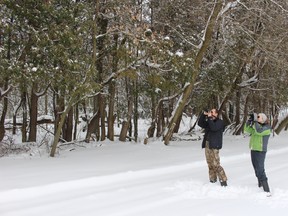Christmas Bird Counters brave the snowy weather to track birds near feeders and in forests across Oxford County and share their results with the longest running citizen science project in the world

Article content
It takes a dedicated birder to wade through chest-deep snow and drive down unplowed country roads at 6 a.m.
But Oxford residents are just that committed to the Christmas Bird Count, the longest running citizen science project in the world.
“This is as much snow as I’ve ever had here, at this time of year. It was tough,” said Jeff Skevington, a scientist and research professor at Carleton University who travels home to Oxford each year to run the Christmas Bird Count.
“I grew up here, so it’s kind of neat to go back to the same place every year,” he said.
The annual Christmas Bird Count is pivotal tool to help conservationists and bird experts paint a picture of populations and track changes from year to year - or decade to decade.
The first stop was the very east edge of Pittock Lake, near the Innerkip bridge, where Skevington and two other birders began their daylong count at first morning light. The team was out traversing the county and counting birds until dark.
“We actually walked through the marsh and it was chest-deep in spots, because it’s all over the cattails, so it was a slog. But we made it through – no heart attacks,” Skevington said.
He suggested the team would further concentrate their searches around feeders and natural food sources thanks to all the snow.
By mid-morning, the trio had already spotted dozens of different species. Mobile technology and apps specifically made for tracking those flying friends have brought convenience to the Christmas Bird Count.
Skevington could instantly see that in the first 195 minutes of the count, his team had spotted more than 30 species, including a Sharp-shinned hawk, Northern harrier hawk, Northern Flicker woodpecker, and “all kinds of things you would think would have left by now.”
Liz Purves joined the Christmas Bird Count in Oxford for the first time on Saturday.
“I was pretty excited to see a Kingfisher,” she said.
“There was open water back there, we saw it dive in and catch a fish,” added Skevington.
But the highlight was a Northern Shrike, Skevingoton said, tapping his phone to pull up a photo and illustration of the bird.
“Shrikes are predators, but they’re not hawks. They don’t have clasping talons. They have a wicked beak and they feed on mice and small birds.”
The extreme cold isn’t a danger for many birds seen on the count, even migrating birds like robins. The main concern is finding enough sustenance.
“As long as there’s fruit, they can stay here. They don’t have to go,” said Skevington, pointing out a tree laden with frozen grapes. “The trick is getting enough food every day to make it through the night. The colder it is, the more fat they burn.”
The birders were getting a workout, too. About 25 people were braving the snow to do their Christmas counting in Oxford, Skevington said. Another dozen or so will also call in their feeder reports.
Thousands of others will report their findings from across the continent and beyond.
“It’s pretty cool to be a part of such a longstanding tradition that people have kept going for over 100 years,” Purves said.
“It’s nice to be a part of that and contribute.”
BY THE NUMBERS
21 birders
28,315 birds spotted
63 species
35 Red-bellied Woodpeckers, a new record for the count
1 Bufflehead, never seen before on the count),
7 Sandhill Cranes, only the fourth time spotted on count
2 Tufted Titmouse, only the third time on count